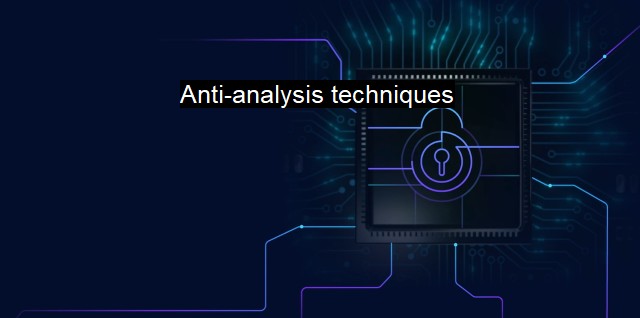What are Anti-analysis techniques?
Challenges and Importance of Anti-Analysis Techniques in Cybersecurity and Antivirus: Defining Sophisticated Methods to Hinder Investigation and Protect Critical Data
Anti-analysis techniques are an array of methodologies deployed by malicious actors with the aim of hindering attempts to understand their harmful software. These actions fall under an umbrella known commonly as code obfuscation, which has been a key feature of cybersecurity threats, posing a major challenge to cybersecurity professionals and antivirus software developers. The whole point is to thwart the means by which malicious software (also known as malware), clandestine activities or harmful cyber threats are analyzed and understood. These sophisticated maneuvers seek to compromise the effectiveness of virus detection efforts, including antivirus software, aimed at securing computer systems and networks against breaches.Understanding these technique generally presupposes knowledge on what cybersecurity is and the role that antivirus software plays in this context. Cybersecurity is the practice of securing computers, servers, mobile devices, electronic systems, networks, and data from malicious attacks. It involves everything from data breaches to identity theft and can come in many forms like malware, phishing, and network attacks. An antivirus plays an integral role in cybersecurity. this software is designed to detect, prevent, and take action to disarm or remove malicious software programs, such as viruses and malware from computers and IT systems.
Anti-analysis techniques have been utilized by threat actors over the years to shield their malicious activities from been deciphered, making it harder for cybersecurity professionals to devise countermeasures in a timely manner. Some of these techniques include packing, crypting, metamorphism, polymorphism, and environmental awareness.
Packing and crypting are often used interchangeably, with both referring to the modification of an executable file's content to disguise the true intent of its underlying code. They serve to dramatically alter the signature of the actual software, thereby circumventing traditional methods of detection.
Metamorphism and polymorphism are complex iterations of packing that go above and beyond encrypting code. Metamorphic viruses rewrite their own code, changing how they appear each time they propagate, thus bypassing signature-based antivirus detections. Polymorphic counterparts, while similar, change their own encryption algorithm each time they infect a new file, adding an extra layer of calculus for antivirus software.
Environmental awareness encourages malware to behave in some ways or desist from an action based on certain cues in the environment, typically in response to specific system settings or states of being. This can make the process of identifying them via traditional efficient antivirus scanning algorithms not only difficult but nigh on unpredictable, increasing the chance of a successful attack.
The tools to combat these disconcerting security threats are evolving proportional to attackers' increasing sophistication. Heuristic analysis and sandboxing represent the way forward for cybersecurity and antivirus developers. Heuristic analysis allows antivirus software to determine whether a file is potentially malicious without needing to have 'seen' it before, and sandboxing, provides an isolated operating environment within which unproven or unverified programs can be safely executed, both prove invaluable.
Antivirus reliance on static indicators and heuristic-based detection can lead to false positives, giving problematic alerts or missing out on actual threats. Cybersecurity experts are therefore working on further innovations,AIOps (Artificial Intelligence for IT Operations) for instance, to improve threat prediction, detection, and response.
One could portray anti-analysis techniques as a game of cat and mouse between attackers and defenders, each striving to outdo the other in this ongoing cybersecurity war. While attackers continue to fine-tune their armory, professionals dedicated to cybersecurity and antivirus development are correspondingly amping up their tactics build resilient defenses and counterattacks. Notwithstanding, the landscape of these techniques is continually and rapidly evolving, making the future of cybersecurity more challenging than ever.

Anti-analysis techniques FAQs
What are anti-analysis techniques in cybersecurity?
Anti-analysis techniques are used to protect malware from being detected and analyzed by antivirus programs. These techniques can include code obfuscation, anti-debugging techniques, and anti-VM techniques.What is code obfuscation in anti-analysis techniques?
Code obfuscation is the practice of intentionally making the code of a malware sample difficult to understand. This can involve techniques such as renaming variables, adding unnecessary code, and using complex control flow. The goal is to make it harder for analysts to understand how the malware functions.What are anti-debugging techniques?
Anti-debugging techniques are used to prevent malware from being analyzed using a debugger. These techniques can include checking for the presence of a debugger or using code that stops the debugging process. The goal is to make it harder for analysts to step through the code and understand how the malware functions.What are anti-VM techniques?
Anti-VM techniques are used to detect if the malware is being run in a virtual machine (VM) environment. If the malware detects that it is running in a VM, it may change its behavior, making it harder for analysts to understand how the malware functions. Anti-VM techniques can include checking the registry for VM-related keys, checking for the presence of virtual drivers, and checking the timing of certain events.| | A | | | B | | | C | | | D | | | E | | | F | | | G | | | H | | | I | | | J | | | K | | | L | | | M | |
| | N | | | O | | | P | | | Q | | | R | | | S | | | T | | | U | | | V | | | W | | | X | | | Y | | | Z | |
| | 1 | | | 2 | | | 3 | | | 4 | | | 7 | | | 8 | | |||||||